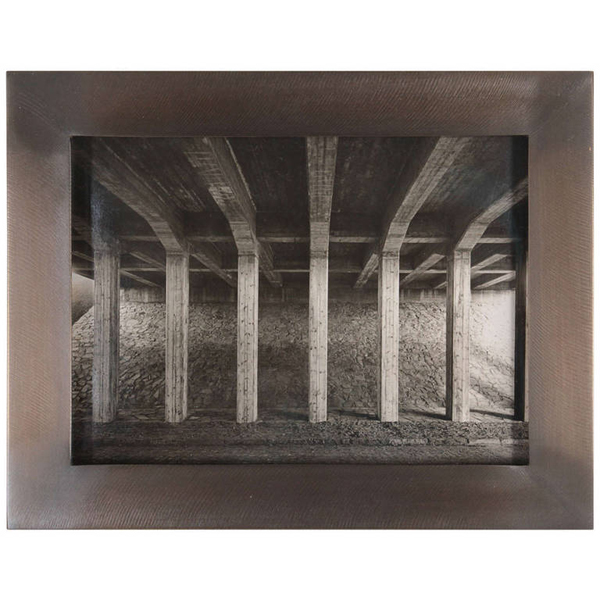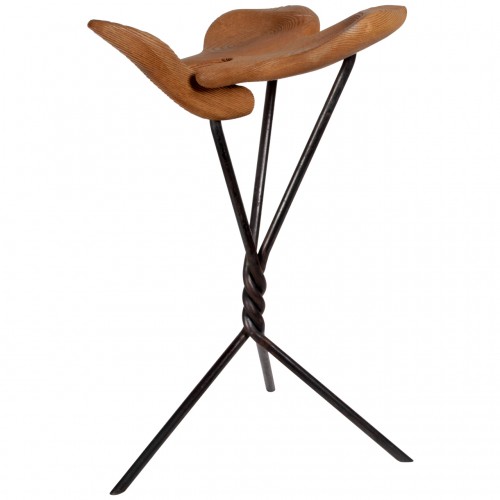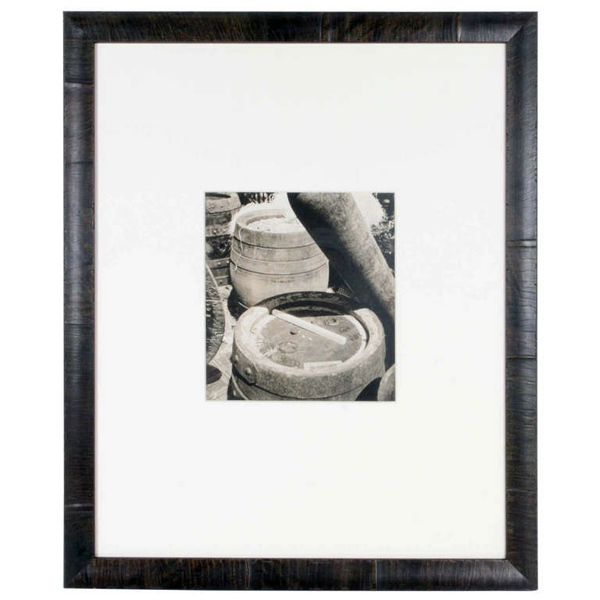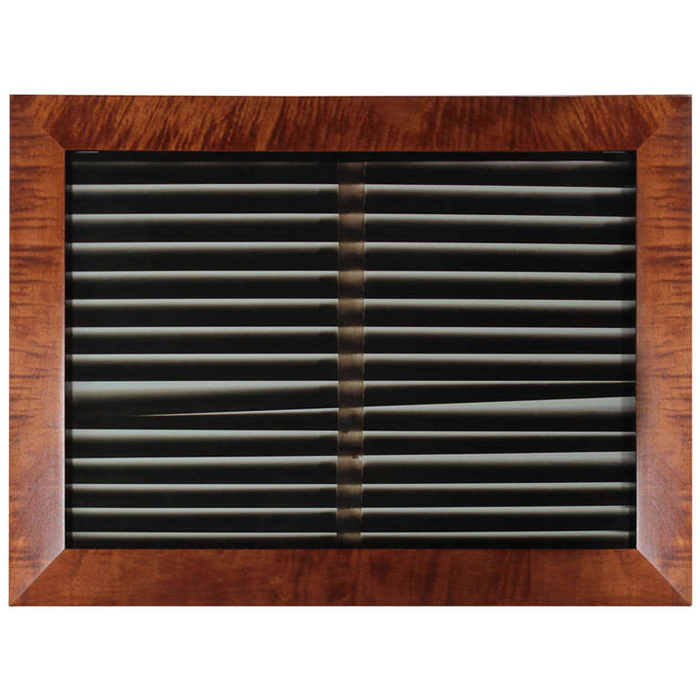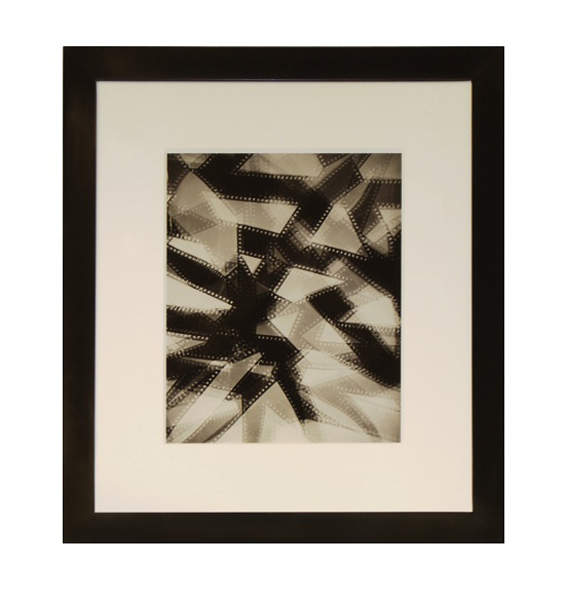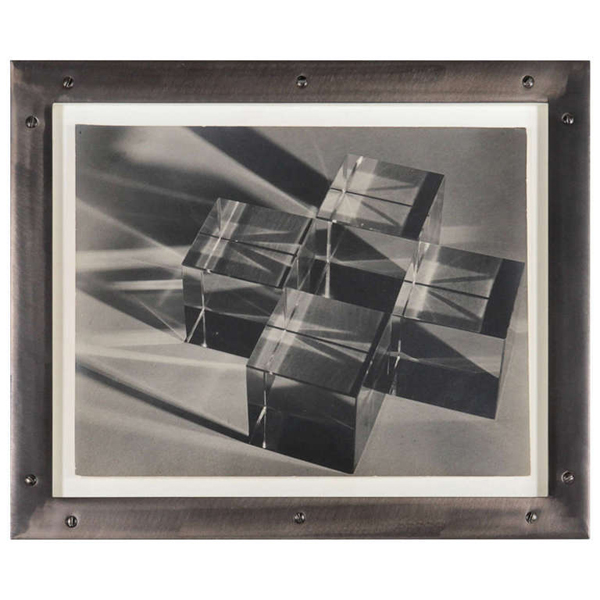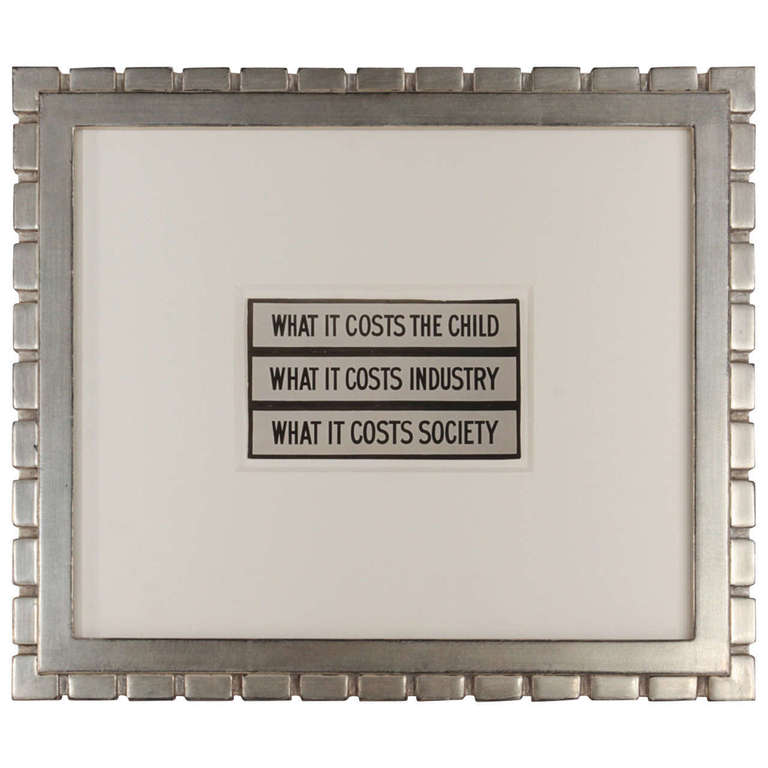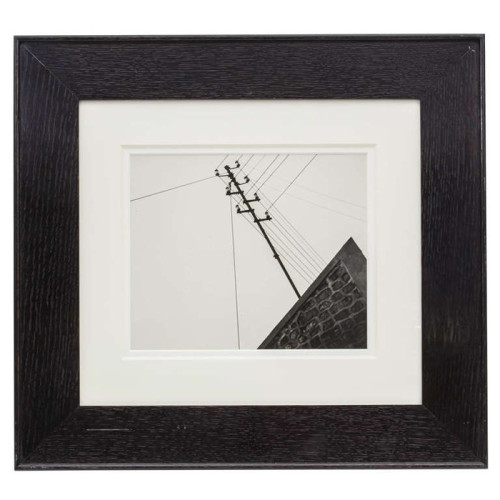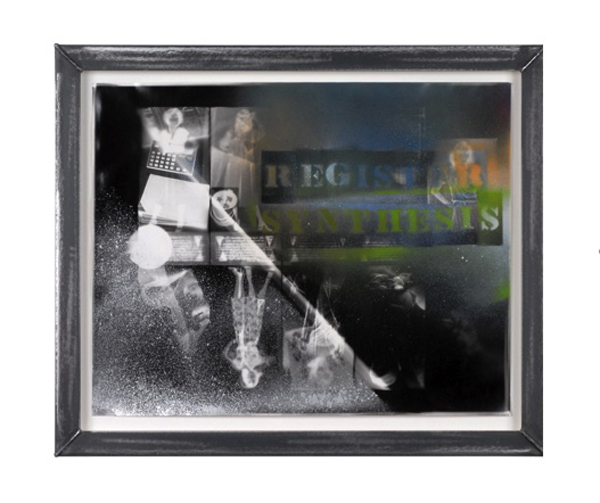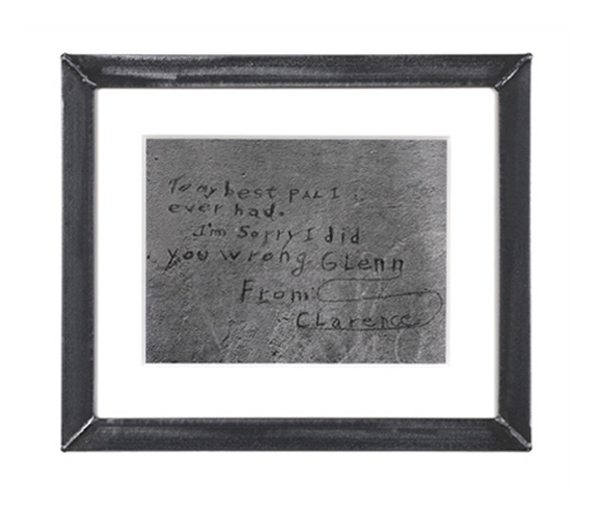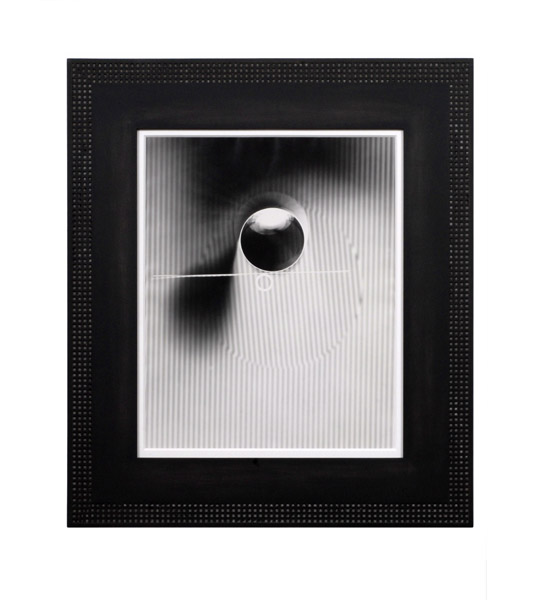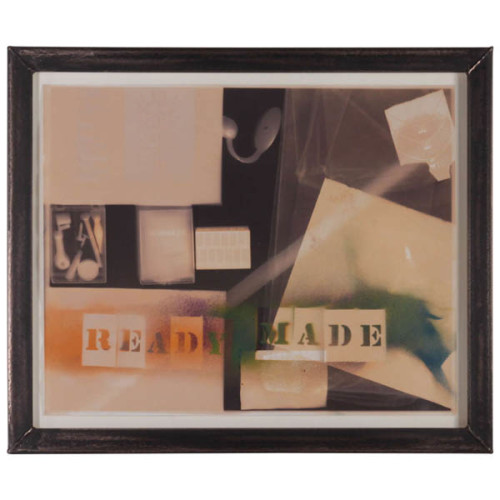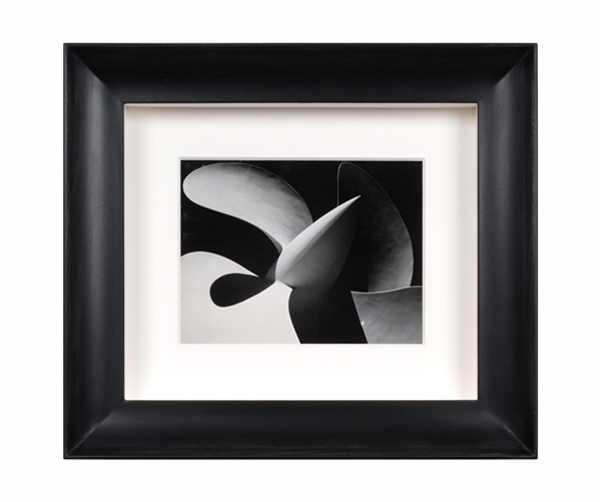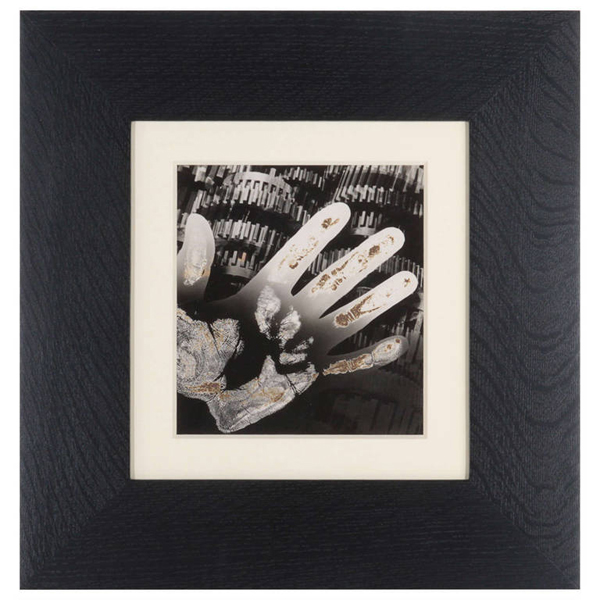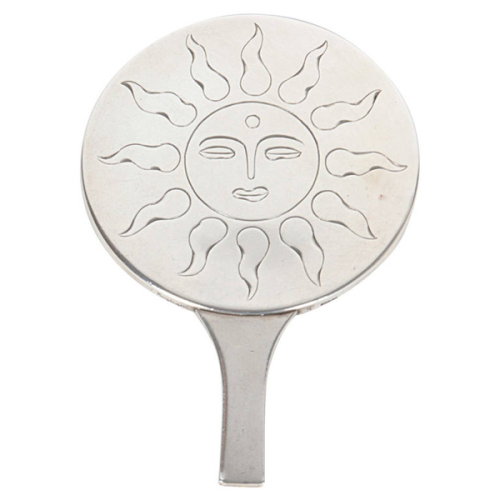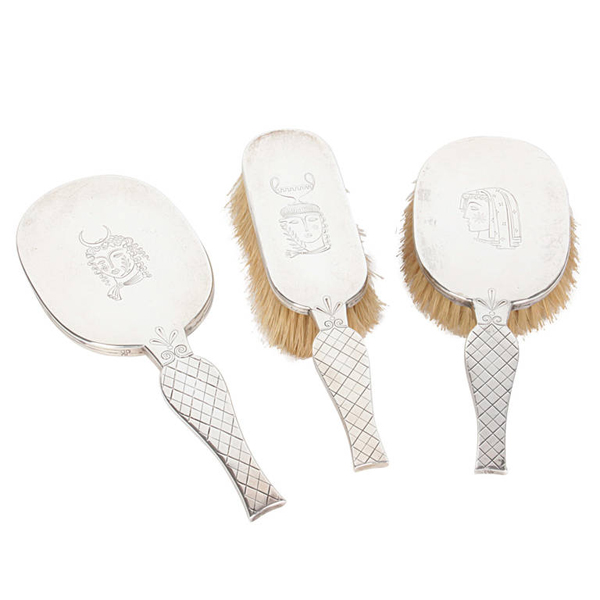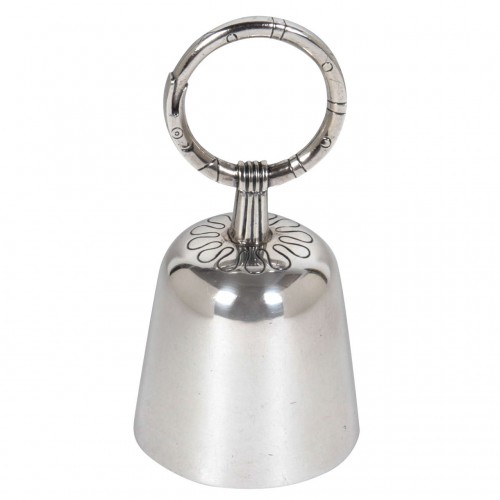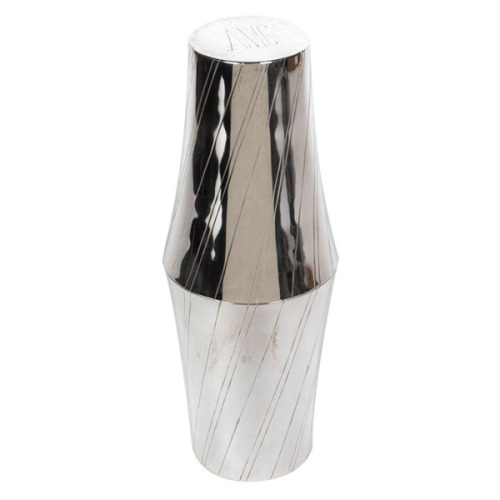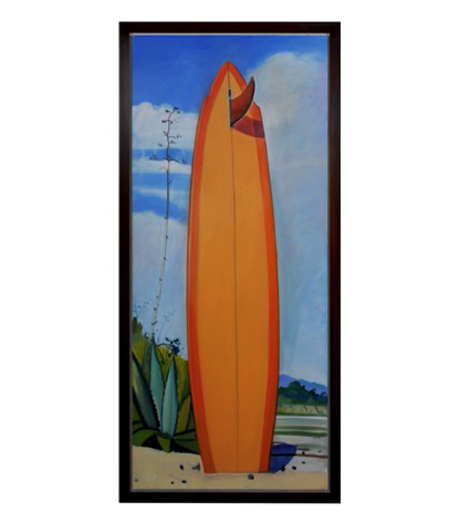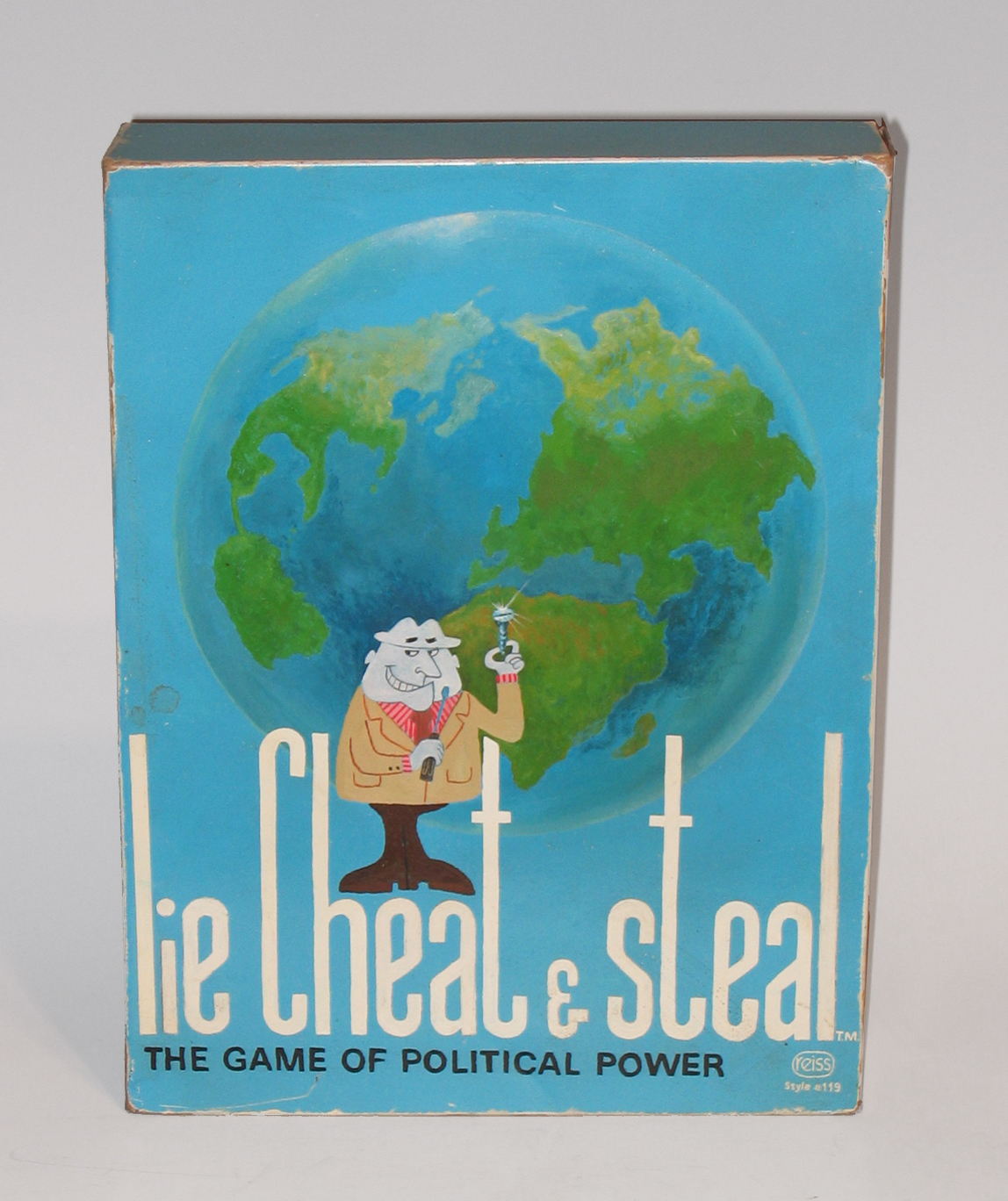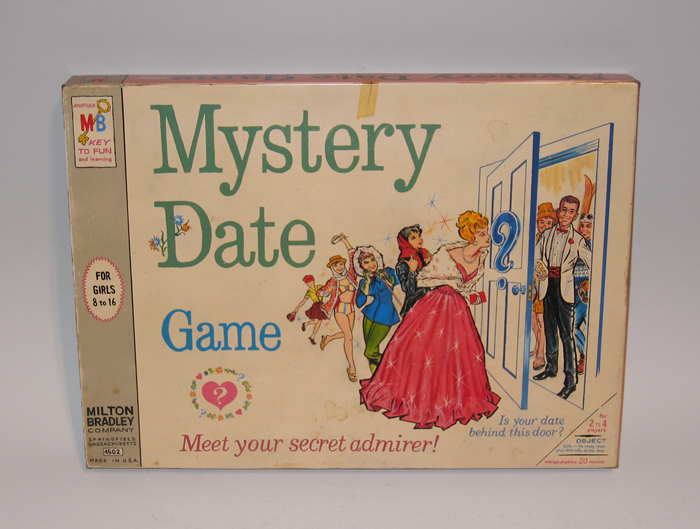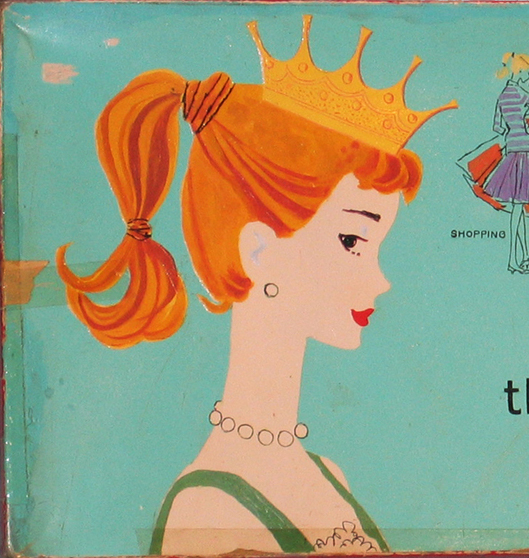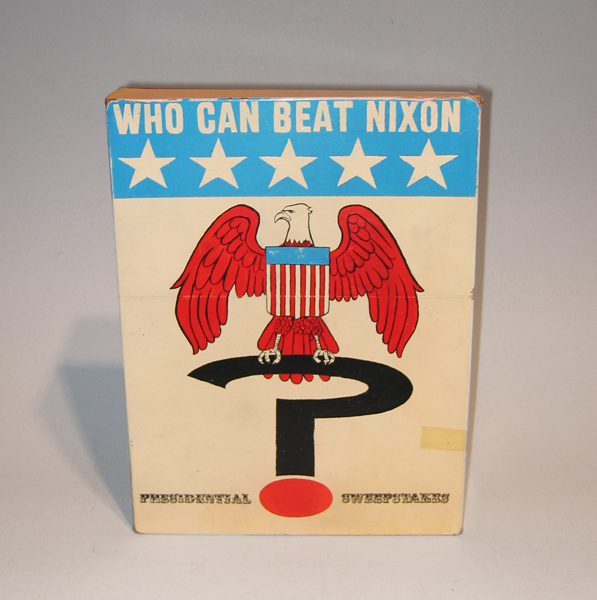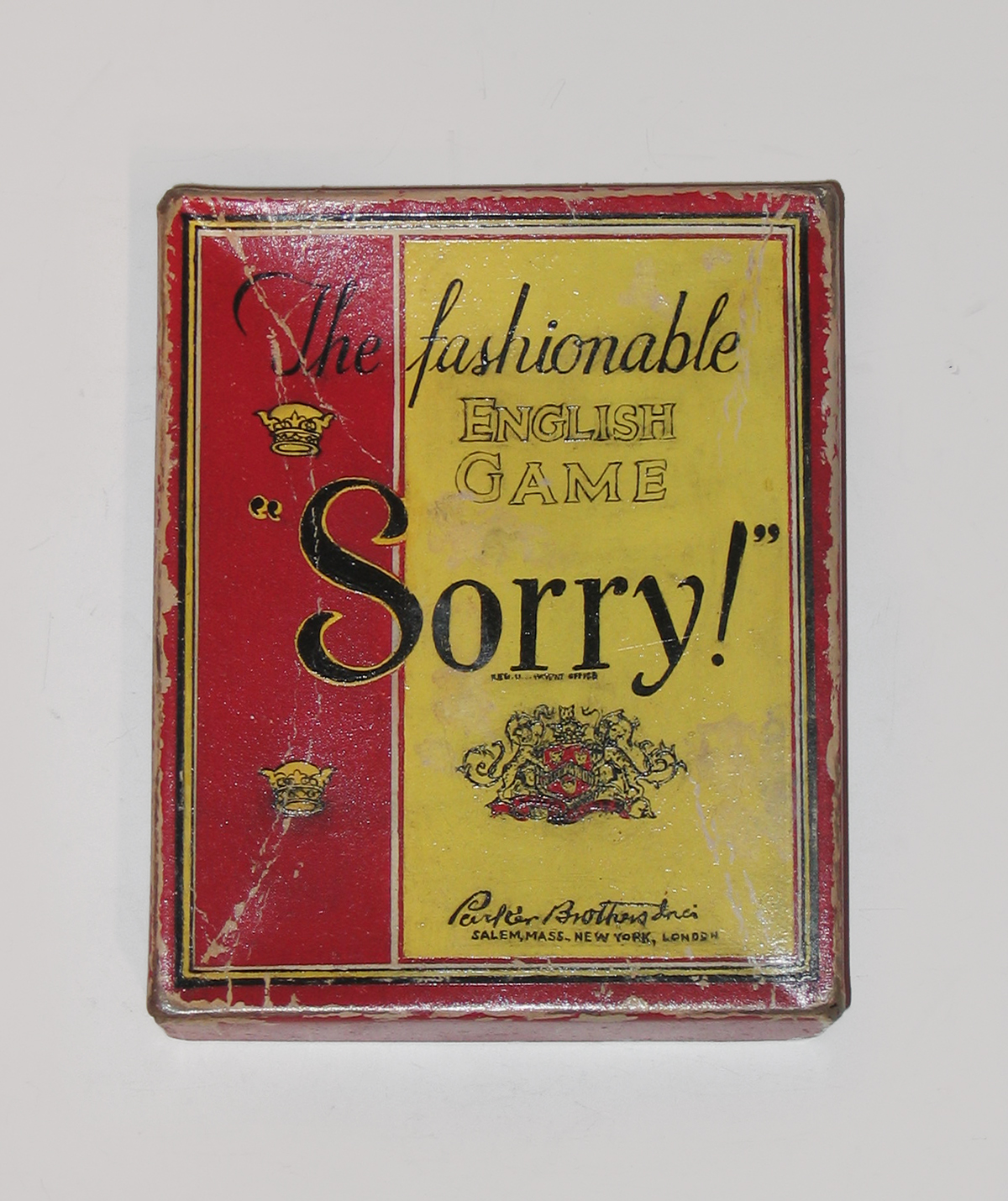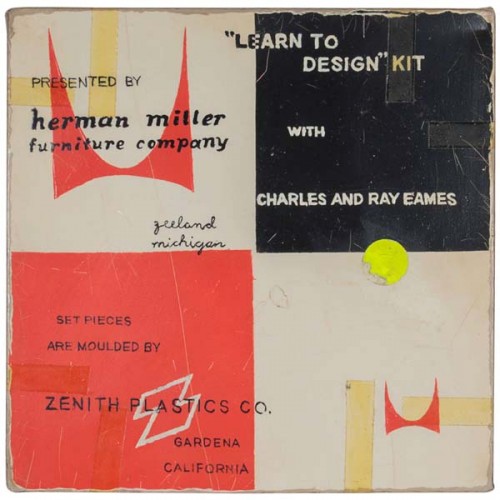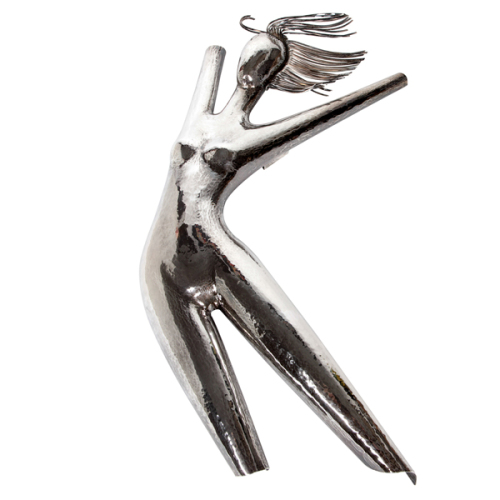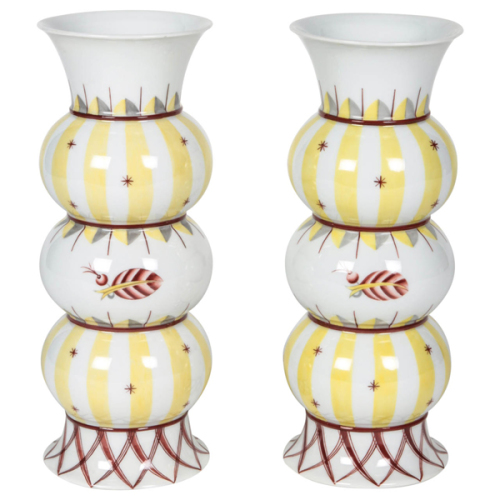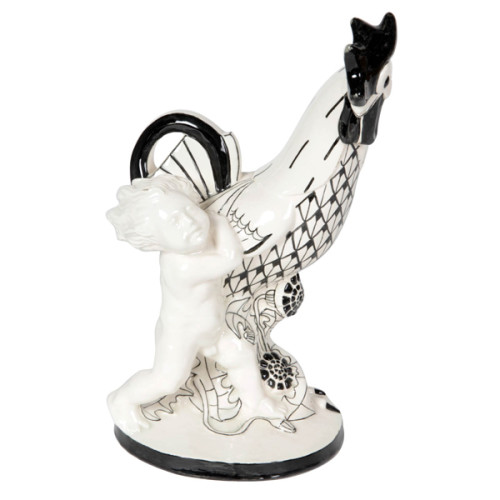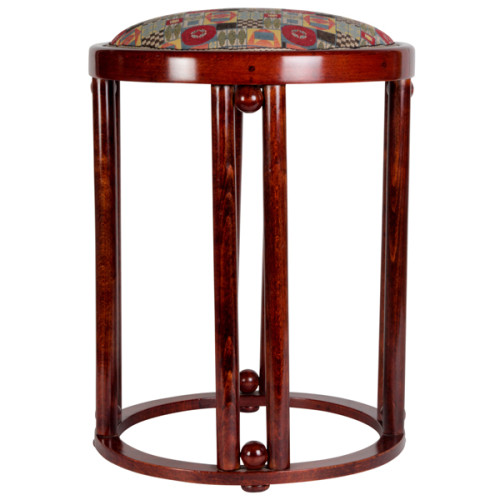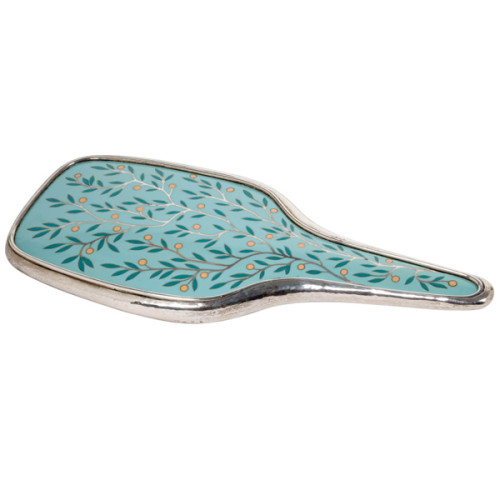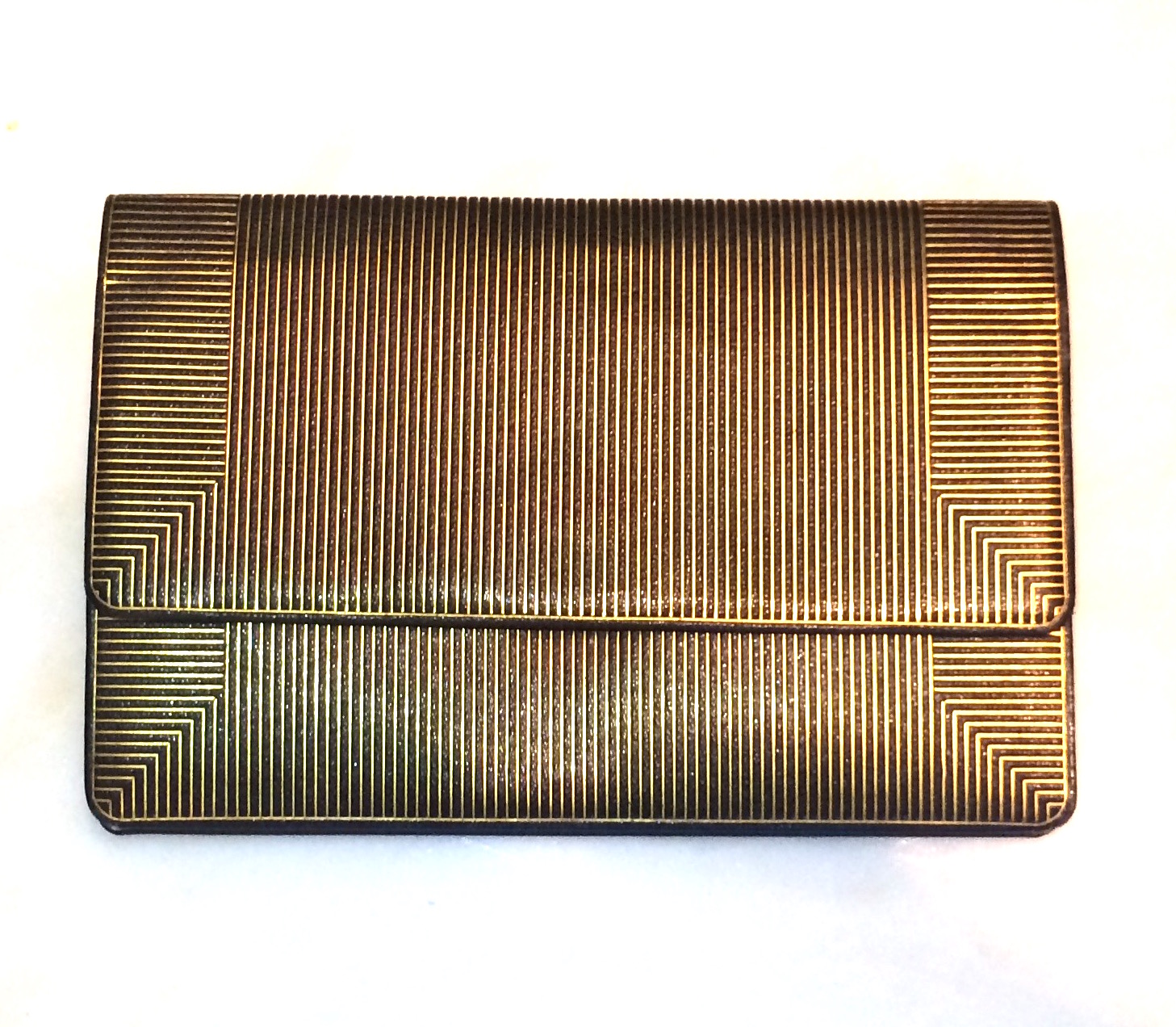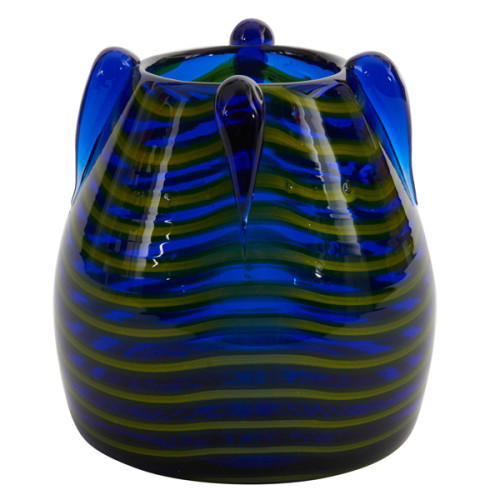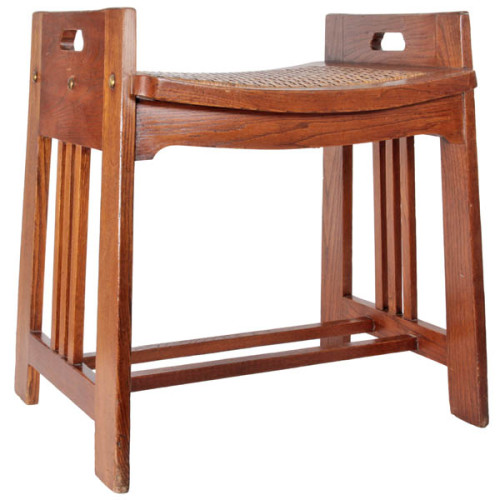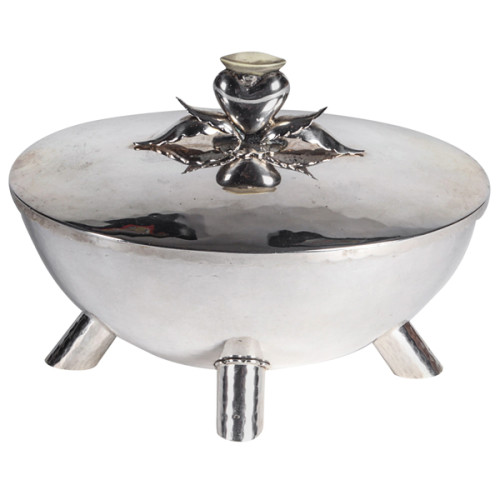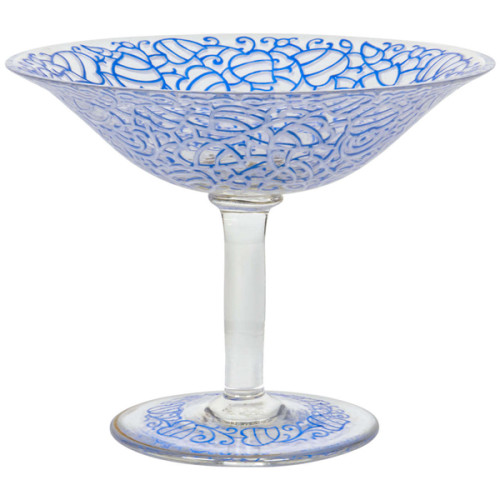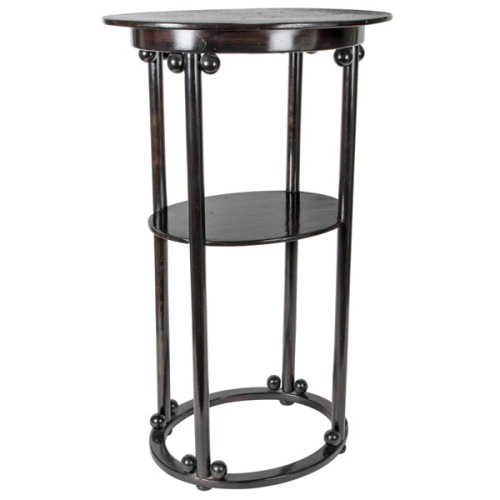product
-
Werner Mantz, Untitled, Gelatin silver print 1929
WERNER MANTZ (1901-1983) Germany
Untitled 1929 (vintage)
Silver gelatin print, patinated bronze frame
Signed: W. Mantz 1929 (in pencil on back)
Framed size: H: 8 ¾” x W: 11”
Price: $42,500
Werner Mantz is regarded as one of the most gifted architectural photographers of the twentieth century. His talent in this field we recognized early in his career and he received numerous commissions from a variety of prominent architects, first in Germany and later in the Netherlands. His work in Cologne especially, from the mid-1920s to the early 1930s, forms a definitive statement of the Neue Sachlichkeit movement in architecture.
Works by Werner Mantz can be found in the collections of the Metropolitan Museum of Art in New York, The Museum of Modern Art in New York, The Art Institute of Chicago, Tate London and many more.
-
Nigel Coates, Rare, Early and Iconic Genie stool 1988
NIGEL COATES (b. 1949) England
BRANSON COATES ARCHITECTURE London“Genie” stool 1988
Carved and sandblasted solid ash seat on twisted mild steel legs
Marks: NIGEL COATES GENIE STOOL
Illustrated: 1000 chairs, Charlotte & Peter Fiell (Cologne: Taschen Verlag, 1997), p. 615.H: 26: x D: 13 1/2″
Price: $9,500
British architect and designer. He studied at Nottingham University and the Architectural Association, London, where he graduated in 1974 and subsequently taught until 1989. In 1983 he formed the group NATO (Narrative Architecture Today) with a group of former students and began to practice independently; two years later he went into partnership with Doug Branson (b 1951). Coates became known for his fluid and lively graphic style and the overt theatricality of his designs. His proposals for the redevelopment of London, involving sophisticated allegories of popular culture, were shown in two exhibitions: ArkAlbion (1984), with drawings of new development areas such as County Hall and the Isle of Dogs, and Ecstacity (1992), with computer simulations and video clips. In the renovation (1980) of his own flat in London he juxtaposed the original, ornate late 19th-century interior with ‘found’ furniture and decorative objects. The publication of this project brought Coates to the attention of Japanese clients who were seeking fashionable Western designers, and he carried out several projects in Japan that became increasingly theatrical: in Tokyo the Metropole Restaurant (1985) evokes a European café, while the Parco Café Bongo (1986) juxtaposes classical English furniture with an imitation aeroplane wing mounted on the ceiling; and the Arca di Noè (1988), Sapporo, is an eclectic mixture of classical motifs and a concrete boat. Coates’s radical approach was dissipated in later British works, such as a series of London shops: one for Katharine Hamnett in Sloane Street (1988) has a shop front formed of aquaria, and one for Jigsaw in Knightsbridge (1992) has its shop front formed of a two-storey copper column in the shape of a phallus. In 1992 he began designing an extension to the Geffrye Museum, London.
Coates was an influential teacher at the Architectural Association from 78- 86, and has lectured extensively abroad. In 1995 he was appointed Professor of Architectural Design at the Royal College of Art and now divides his time equally between the college and his office. Nigel Coates furniture is represented in the Modern Furniture Collection of the Victoria & Albert Museum, London.“I go for architecture that overlays and enhances. By blending observation and wit with reason, I want my work to generate a sense of the unexpected, and the seemingly spontaneous.”
-
Donald Deskey, Barrels, Gelatin silver print, c.1925-30
DONALD DESKEY (1894-1989) USA
Barrels c.1925-30
Silver gelatin print, ebonized textured wood frame
Provenance: The Estate of Donald Deskey
H: 9 7/8” x W: 7 15/16”
Framed: H: 22” x W: 18”Price: $4,200
Donald Deskey was a native of Blue Earth, Minnesota. He studied architecture at the University of California, but did not follow that profession, becoming instead an artist and a pioneer in the field of Industrial design. In Paris he attended the 1925 Exposition Internationale des Arts Décoratifs et Industriels Modernes, which influenced his approach to design. He established a design consulting firm in New York City, and later the firm of Deskey-Vollmer (in partnership with Phillip Vollmer) which specialized in furniture and textile design. His designs in this era progressed from Art Deco to Streamline Moderne.
He first gained note as a designer when he created window displays for the Franklin Simon Department Store in Manhattan in 1926. In the 1930's, he won the competition to design the interiors for Radio City Music Hall. In the 1940's he started the graphic design firm Donald Deskey Associates and made some of the most recognizable icons of the day. He designed the Crest toothpaste packaging, as well as the Tide bullseye. His company is still in operation in Cincinnati. A collection of his work is held by the Cooper-Hewitt, National Design Museum. He is regarded the American pioneer of industrial design, and contemporary American graphic design.
-
Aram Gesar, Venetian Blinds, Ciba-chrome print 1979
ARAM GESAR USA
Venetian Blinds 1979
Ciba-chrome print, maple frame
Signed: 790069, LXXIX (on back)
Framed size: H: 17 9/16” x W: 23 ½”
Price: $24,000
Aram Gesar has been published internationally and has exhibited his photographic work in New York, San Francisco, Zurich and Geneva since 1977. As a producer, art director and photographer, Gesar created advertising campaigns for major corporations in the U.S. and Europe focusing on the fields of travel, banking, financial services, aerospace and motion pictures. He also created and produced documentaries on travel, aviation and yachting for national cable networks and the home video markets and television commercials and corporate programs for various U.S. and European corporations.
Gesar is currently one of the leading international experts on travel and air transport, and the founder and CEO of The Pyramid Media Group, which includes several magazines, newsletters, web sites, books, eBooks and other publications integrating a spectrum of business, travel and aviation content.
-
Allen Porter, Filmstrips, Photogram vintage gelatin silver print 1947
ALLEN PORTER (b.1926) USA
Filmstrips 1947
Photogram vintage gelatin silver print
Size: (unframed): H: 11” x W: 14”
Size: (frame): H: 20” x W: 23”After attending art programs at the Art Institute of Chicago and the Chicago Academy of Fine Arts, Porter enrolled at the ID upon his return from military service in WWII. His course of study included graphic design and photography. His photograms were produced while working with famed ID photography instructors Frank Levstik and Ferenc Berko. Shortly after leaving the ID in 1949, Porter established a design office in Los Angeles during the height of the California modern design movement. He incorporated his innovative light work into design projects for important clients like Gruen Lighting and Carroll Sagar & Associates.
-
Carlotta Corpron, Light Cubes, Gelatin silver print c. 1947
CARLOTTA CORPRON (1901-1988) USA
Light Cubes c. 1947
Silver gelatin print, patinated steel frame
Signed: Carlotta M. Corpron, Denton, Texas, RM6 #1081.47 (stamped on back)
Framed size: H: 13 ¾” x W: 16 ¾”
Price: $40,000
Corpron became a teacher at Texas Woman’s University in 1935 and in 1942 she led a light workshop at Texas Woman’s University for photographer Laszlo Moholy-Nagy. Although he praised her rapport with her students, Moholy-Nagy did not encourage Corpron’s independent photography. More influential on her work was the arrival of Gyorgy Kepes, who came to Denton to write a book in 1944. His interest in Corpron’s work prompted her to produce several series of photographs that were the most original of her career. At his suggestion Corpron experimented by placing white paper cut in simple shapes within a perforated box that was open at one end. When flashlights were shined through the holes onto the paper shapes, interesting patterns of light and shadow were reflected. The resulting abstract photographs comprised Corpron’s “Light Patterns” series.
In her “Light Follows Form” series she extended her exploration of the modeling properties of light to three-dimensional form. In this series, she used light filtered through Venetian blinds or glass to dramatize a plaster cast of a Greek head. She also experimented with solarization, a process in which already exposed negatives are exposed. Works such as Solarized Calla Lilies (1948) convey a surreal elegance, but Corpron favored more original methods of expression. She regarded her “Space Compositions” and “Fluid Light Designs” series as her best work. In the former she used still-lifes composed of eggs, nautilus shells, or glass paperweights, usually combined with a curving reflective surface, to produce an illusion of receding three-dimensional space. She emphasized distortions of form that occurred in her egg photographs by experimentation during the development process. Her work is included in the collections of the Museum of Modern Art in New York City, the Art Institute of Chicago, the New Orleans Museum of Art, the Dallas Museum of Art, and the Amon Carter Museum in Fort Worth.
-
Lewis Hine, What It Costs The Child/Industry/Society, Silver gelatin print c. 1913-14
LEWIS HINE (1874-1940) USA
What It Costs The Child/Industry/Society c. 1913/14
Silver gelatin print
Signed in script on back
Framed size: H: 14 1/8” x W: 16 3/16”
Price: $20,000
***The same image is in the collection of the Metropolitan Museum of Art, New York.
Lewis Wickes Hine, photographer, sociologist and humanist, is best known for his insightful portraits of immigrants at Ellis Island and his unflinching views of housing and labor conditions in the United States. Studying and eventually teaching at the Ethical Culture School in New York City, Hine infused his humanist concerns into a style of documentary photography that set the standard for delivering a social message through his medium.
The Artist's Joke surveys the rich and diverse uses of satire by avant-garde and contemporary artists. The texts collected in this new reader from London's Whitechapel Gallery examine what Andre Breton called the “lightning bolt” of the unsettlingly comic, as seen in the anarchic wordplay of Duchamp, Picasso, the Dadaists, and Surrealists; Pop's fetish for kitsch and the comic strip; Bruce Nauman's sinister clowns and twisted puns; Richard Prince's joke paintings; art ambushed by feminist wit, from the Dadaism of Hannah Hoch in the 1920s to the politicized conceptualism of Jenny Holzer and Barbara Kruger in the 1980s; the serenely uncanny in Mike Kelley's installations and the risibly grotesque in Paul McCarthy's; and the strangely comic scenarios of artists as various as Maurizio Cattelan, Andrea Fraser, Raymond Pettibon, and David Shrigley. Artists' writings are accompanied and contextualized by the work of critics and thinkers including Freud, Bergson, Helene Cixous, Slavoj Zizek, Lewis Wickes Hine, Jorg Heiser, Jo Anna Isaak, and Ralph Rugoff.
-
Nathan Lerner, Dowels Light Box Study, Silver gelatin print c. 1937
NATHAN LERNER (1913-1997) Chicago, USA
Dowels Light Box Study c.1937
Silver gelatin print
Signed on back
Illustrated: New Bauhaus, 50 Jahre: Bauhausnachfolge in Chicago (Berlin: Bauhaus-Archiv and Argon Verlag GmbH: 1987), p. 177
H: 18 5/8” x 22 ½” (framed)
Nathan Lerner’s long career was inextricably bound up in the history of visual culture in Chicago. Born in 1913 to immigrants from Ukraine, he began studying painting at the Art Institute of Chicago at the age of 16, taking up the camera to perfect his compositional skills. At 22 he began doing a kind of photojournalism, developing his well-known series on ”Maxwell Street,” an immigrant neighborhood hit hard by the Depression, and also photographing the southern Illinois mining area. In 1936 when the New Bauhaus was established in Chicago by Lazlo Moholy-Nagy, Lerner became one of its first scholarship students and turned increasingly to photographic experimentation. He began making semi-abstract, strongly Constructivist images involving luminous projections, solarization, photograms and other methods, and his interest in manipulating light led him to invent the first ”light box.” In 1939 he became the assistant of Gyorgy Kepes, head of the school’s light workshop; together, they wrote ”The Creative Use of Light” (1941). With Charles Niedringhaus in 1942 he developed a machine for forming plywood that was used in making most of the school’s furniture. After working as a civilian light expert for the Navy in New York during World War II, Lerner returned to the school, now called the Institute of Design, and was named education director after Moholy-Nagy’s death in 1946. He left in 1949, opening a design office that became nationally known for its furniture, building systems and glass and plastic containers (including bottles for Revlon and Neutrogena and the Honeybear honey container). In 1968 Lerner married Kiyoko Asia, a classical pianist from Japan, and over the next two decades made numerous trips to Japan, where he took his first color photographs, as well as Mexico. He had his first solo exhibition of photography in 1973 and thereafter exhibited regularly in galleries and museums in the United States, Europe and Japan. His work is included in photography and design collections around the world. (Roberta Smith, New York Times, February 15, 1997).
-
Andre Kertesz, Paris, Gelatin silver print 1927
ANDRÈ KÈRTESZ (1894-1985) Hungary
Paris 1927
Silver gelatin print
Signed: Paris 1927, A.Kertesz, Page 150 (in pencil on back); ANDRÈ KÈRTESZ (stamped on back).
Framed size: H: 16 5/8” x W: 17 13/16”
Throughout most of his career, Kertész was depicted as the “unknown soldier” who worked behind the scenes of photography, yet was rarely cited for his work, even into his death in the 1980s. His work itself is often described as predominantly utilizing light and even Kertész himself said that “I write with light”. He was never considered to “comment” on his subjects, but rather capture them – this is often cited as why his work is often overlooked; he stuck to no political agenda and offered no deeper thought to his photographs other than the simplicity of life. With his art’s intimate feeling and nostalgic tone, Kertész’s images alluded to a sense of timelessness that was inevitably only recognized after his death. Unlike other photographers, Kertész’s work gave an insight into his life, showing a chronological order of where he spent his time; for example, many of his French photographs were from cafés where he spent the majority of his time waiting for artistic inspiration. Although Kertész rarely received bad reviews, it was the lack of them that lead to the photographer feeling distant from recognition. Now however, he is often considered to be the father of photojournalism. Even other photographs cite Kertész and his photographs as being inspirational; Henri Cartier-Bresson once said of him in the early 1930s, “We all owe him a great deal”.
-
György Kepes, Abstraction, Gelatin silver print 1942
GYÖRGY KEPES (1906-2001) Hungary/USA
Abstraction 1942
Silver gelatin print
Signed: Gyorgy Kepes 1942 (in ink on back)
Framed size: H: 18 13/16” x W: 16”
György Kepes was a Hungarian-born painter, designer, educator and art theorist. After emigrating to the U.S. in 1937, he taught design at the New Bauhaus (later the School of Design, then Institute of Design, then Illinois Institute of Design or IIT) in Chicago. In 1947 He founded the Center for Advanced Visual Studies at the Massachusetts Institute of Technology (MIT) where he taught until his retirement in 1974.
-
Thomas F. Barrow, Register Synthesis, Gelatin silver print photogram with applied spray paint, 1978
THOMAS F. BARROW (b. 1938) Kansas City, MO
Register Synthesis Photogram 1978
Gelatin silver print photogram with applied spray paint
Signed: Register Synthesis – 1978 – Thomas F. Barrow (in ink on back)
Exhibited: J.J. Brookings & Co. (San Jose, CA): Thomas F. Barrow: Inventories and Transformations, A Twenty Year Retrospective, Nov. 6 – Dec. 16, 1986. This exhibit occurred simultaneously with the following two museum shows: the San Francisco Museum of Modern Art (Nov. 6, 1986 – Jan 11, 1987) and the Los Angeles County Museum of Art (Feb. 26 – May 10, 1987).
Related photograph illustrated: Aperture: The New Vision: Forty Years of Photography, no. 87 (New York: Aperture Foundation, Inc., 1987), cover image.
Framed size: H: 19 5/8” x W: 23 7/16”
Thomas Barrow, American was born in Kansas City, Missouri. He studied at the Art Institute of Design in Chicago, Illinois and received his M.A. in 1967. At the George Eastman House, Barrow was the Assistant Director from 1971 to 1972 and served as the Associate Director of the University of New Mexico Art Museum from 1973 to 1976. Barrow started teaching photography in 1976 in the Art Department of the University of New Mexico and by 1985 he became the Acting Director of the University Art Museum. His Midwestern academic pedigree includes studying with Aaron Siskind at the Art Institute of Design in Chicago and with filmmaker Jack Ellis at Northwestern University in Evanston, IL. Barrow has received two NEA Photographers Fellowships in 1973 and 1978.
Barrow has produced a series of silver-gelatin photograms and then applied spray paint to the prints. These combine the feeling of a split-toned black and white print and at the same time appear as color-print photograms. He has produced a series of photograms entitled Disjunctive Forms. His images appear as surreal assemblages of various found and created objects superimposed with stencil text. Barrow works in the “academic” tradition—his pictures are deliberately and consistently experimental, highly intellectualized, scholarly in their concerns, and chock-full of references to the work of other artists.
-
John Gutmann, D.O.S. Apology, Gelatin silver print, 1938
JOHN GUTMANN (1905-1998) USA
D.O.S. Apology 1938
Signed: 290.6, M 3 (in a circle), 5, © John Gutmann, SP, D.O.S. Apology 1938 (all in pencil on back of photo)
Framed size: H: 12 1/8“ x W: 14 3/8”
John Gutmann was a German-born American photographer and painter. After fleeing Nazi Germany to the United States, Gutmann acquired a job as a photographer for various German magazines. Gutmann quickly took an interest in the American way of life and sought to capture it through the lense of his camera. He especially took an interest in the Jazz music scene. Gutmann is recognized for his unique “worm’s-eye view” camera angle. He enjoyed taking photos of ordinary things and making them seem special.His work was shown in important galleries such as Castelli’s in NYC, Fraenkel in San Francisco, and the Centre National de la Photographie in Paris. After his death, Gutmann’s oeuvre was given to the Center for Creative Photography at the University of Arizona.
-
György Kepes, Abstraction, Gelatin silver print, 1942
GYÖRGY KEPES (1906-2001) Hungary/USA
Abstraction 1942
Silver gelatin print
Signed: 9 (in a circle, on back); Gyorgy Kepes 1942 (in ink on back)
György Kepes was a Hungarian-born painter, designer, educator and art theorist. After emigrating to the U.S. in 1937, he taught design at the New Bauhaus (later the School of Design, then Institute of Design, then Illinois Institute of Design or IIT) in Chicago. In 1947 He founded the Center for Advanced Visual Studies at the Massachusetts Institute of Technology (MIT) where he taught until his retirement in 1974.
Framed size: H: 29 3/16” x W: 25 ¼”
-
Thomas F. Barrow, Ready Made, Gelatin silver print photogram with applied spray paint, 1978
THOMAS F. BARROW (b. 1938) Kansas City, MO
Ready Made Photogram 1978
Gelatin silver print photogram with applied spray paint
Signed: Ready Made – 1978 – Thomas F. Barrow (in ink on back)
Exhibited: J.J. Brookings & Co. (San Jose, CA): Thomas F. Barrow: Inventories and Transformations, A Twenty Year Retrospective, Nov. 6 – Dec. 16, 1986. This exhibit occurred simultaneously with the following two museum shows: the San Francisco Museum of Modern Art (Nov. 6 – Jan 11, 1987) and the Los Angeles County Museum of Art (Feb. 26 – May 10, 1987).
Related photograph illustrated: Aperture: The New Vision: Forty Years of Photography, no. 87 (New York: Aperture Foundation, Inc., 1987), cover image.Framed size: H: 19 5/8” x W: 23 7/16”
-
Berenice Abbott, Beams of Light Through Prism, Gelatin silver print, c. 1960
BERENICE ABBOTT (1898-1991) USA
Beams of Light Through Prism c. 1960
Silver gelatin print
Signed: BERENICE ABBOTT (in pencil below photo)
H: 25 ½” x W: 26 7/16” (framed)
-
Pierre Boucher, Propeller, Gelatin silver print, 1935
PIERRE BOUCHER (1908-2000) France
Propeller 1935
Signed: WB – 7252; Photo Pierre Boucher (ink stamp); DBoucher (ink signature)
Provenance: Gene Prakapas Gallery, New York, 1978.
H: 7 1/16” x W: 9 ¼” (unframed)
H: 14 11/16” x 16 11/16” (framed)
Pierre Boucher came to photography as a result of the Nouvelle Vision and he explored photography as an experiment on all levels, photograms, collages, solarization and superimposition. He had a natural curiosity and a cultivated and sporty demeanor that led him to produce work as diverse as surrealist nudes and well-constructed advertisements. Whether it be in documentary photography or industrial photography, Pierre Boucher always awakens an empathy and a feeling of closeness with his subjects in the spectator.
Pierre Boucher got his start in advertising, taking his inspiration from the graphic techniques of the modernists in the field and contributing to the transformation of the advertising photo into a work of art. He used photomontage to make his work more striking and effective, making unnerving and astonishing.
Boucher’s nudes, on the other hand, use no technical prowess whatsoever. After the war the movement for freedom of the body led him to reconsider social models. Pierre Boucher revisited the female and male nude from several angles. Around 1931, he did his first nude photos under the umbrella of the “ New Objectivity ” : the image was boxed, the frame strict, the bodies freed from their faces. From 1933 onwards his nudes became surrealist inspired by the work of Man Ray. He then moved on to neo-classical nudes. In studio or in natural light his Apollonian nude aimed above all for beauty and harmony.
-
Donald Deskey, Papier-Abfälle, Gelatin silver print, c.1925-30
DONALD DESKEY (1894-1989) USA
Papier-Abfälle c.1925-30
Provenance: The Estate of Donald Deskey
H: 9 7/8” x W: 7 15/16”
Framed: H: 22” x W: 18”Donald Deskey was a native of Blue Earth, Minnesota. He studied architecture at the University of California, but did not follow that profession, becoming instead an artist and a pioneer in the field of Industrial design. In Paris he attended the 1925 Exposition Internationale des Arts Décoratifs et Industriels Modernes, which influenced his approach to design. He established a design consulting firm in New York City, and later the firm of Deskey-Vollmer (in partnership with Phillip Vollmer) which specialized in furniture and textile design. His designs in this era progressed from Art Deco to Streamline Moderne.
He first gained note as a designer when he created window displays for the Franklin Simon Department Store in Manhattan in 1926. In the 1930's, he won the competition to design the interiors for Radio City Music Hall. In the 1940's he started the graphic design firm Donald Deskey Associates and made some of the most recognizable icons of the day. He designed the Crest toothpaste packaging, as well as the Tide bullseye. His company is still in operation in Cincinnati. A collection of his work is held by the Cooper-Hewitt, National Design Museum. He is regarded the American pioneer of industrial design, and contemporary American graphic design.
-
Grant Mudford, Containers, Gelatin silver print, 1979
GRANT MUDFORD (1944- ) Australia
Containers 1979
Gelatin silver print
Signed and dated on back
Framed size: H: 26 ½” x W: 30 ¾”
“Since he moved to Los Angeles from Australia in the late 1970s, Grant Mudford has composed photographs that crisply examine the streamlined geometries of West Coast architecture and landscape. Mudford has zeroed in on the abstract formal relationships lurking within the designs of gas stations, strip malls and apartment buildings. The geometrical arrangements highlighted in his photographs of the masterful modernist structures of Rudolf Schindler and Craig Ellwood have disclosed a link between their midcentury architecture and the contemporaneous hard-edge abstractions of L.A. painters John McLaughlin and Lorser Feitelson.” – Art in America, “Grand Mudford at Rosamund Felsen, September 2003
-
György Kepes, Lens Refraction, Gelatin silver print, 1939
GYÖRGY KEPES (1906-2001) Hungary/USA
Lens Refraction 1939
Signed: 6 (in a circle, on back); Gyorgy Kepes 1939 (in pencil on back)
Illustrated: New Bauhaus, 50 Jahre: Bauhausnachfolge in Chicago (Berlin: Bauhaus-Archiv and Argon Verlag GmbH: 1987), p. 185
Framed size: H: 27 1/8” x W: 22 ¼”
György Kepes was a Hungarian-born painter, designer, educator and art theorist. After emigrating to the U.S. in 1937, he taught design at the New Bauhaus (later the School of Design, then Institute of Design, then Illinois Institute of Design or IIT) in Chicago. In 1947 He founded the Center for Advanced Visual Studies at the Massachusetts Institute of Technology (MIT) where he taught until his retirement in 1974.
-
Edmund Kesting, Gears with hand, Photogram / Solarization c.1929
EDMUND KESTING (1882-1970) Germany
Gears with hand c.1929
Photogram / Solarization
Signed: Edmund Kesting 3644-280 (in pencil)
Provenance: Private Collection New York; Gene Prakapas Gallery New York 1970’s
Photogram: H: 7 9/16” x W: 6 15/16”
Frame: H: 15 9/16” x W: 14 15/16”Price: $19,500
During the 1920s, Kesting was at the center of the avant-garde movement in Germany, where he befriended Kurt Schwitters and Laszlo Moholy-Nagy. He first trained as a painter at the Akademie der Kunst in Dresden from 1911 to 1916. In the early 1920s, after service in World War I, he turned to collage and photography. An exhibitor at Herwarth Walden's Der Sturm gallery (Berlin), which supported German expressionism and the Blue Rider group, Kesting also operated several private art schools. The last, Der Weg (The Way), was closed by the Nazis in 1933. Kesting’s interest in the photographic portrait began in 1930, and often resulted in bold experimentation (Photomontages, superimpositions and solarizations) that provided some of the strongest examples of German expressionist portraiture in photography. In contrast to the objective naturalism of August Sander, his work is informed by the “Sturm und Drang” of the period – the storm and stress of the political, economic, and social unrest in Germany. After the war in 1948, Kesting taught at the Kunsthochschule in Berlin-Weissensee. – (partially excerpted from James Borcoman, Magicians of Light, National Gallery of Canada, 1993)
Works by Edmund Kesting can be found in the collections of the Museum of Modern Art in New York and the Los Angeles County Museum of Art.
Solarization — is a phenomenon in photography in which the image recorded on a negative or on a photographic print is wholly or partially reversed in tone. Dark areas appear light or light areas appear dark. The term is synonymous with the Sabattier effect when referring to negatives, but is technically incorrect when used to refer to prints. In short, the mechanism is due to halogen ions released within the halide grain by exposure diffusing to the grain surface in amounts sufficient to destroy the latent image.
-
Hubert Schmalix “Häuserbild” Oil on Canvas 1989
HUBERT SCHMALIX (1952-) Austria
Häuserbild 1989
Oil on canvas
Signed and dated on back: Schmalix 89
Exhibited: Galerie Krinzinger Vienna 1990 (Solo exhibition)
Illustrated: Nach Schiele, Tobias G. Natter and Thomas Trummer (Köln, Germany: Atelier Augarten, DuMont, 2006), p 142.
Provenance: Private Collection Vienna
For related works by Hubert Schmalix see: Hubert Schmalix, Lóránd Hegyi exhibition catalog (Museum Moderner Kunst StiftungLudwig Wien) November 19, 1994 – January 1995.
H: 85” x W: 49”
Hubert Schmalix was born in Graz, Austria, on December 17, 1952 and studied at the Vienna Art Academy from 1971 to 1976. By 1979 Schmalix was showing work at the forward-looking exhibition ‘Europa 79 – Kunst der 80er Jahre’ in Stuttgart. In 1983 the London Tate Gallery invited Schmalix to present work at ‘New Art’, an important survey of contemporary art. Schmalix has become well-known world-wide as an exponent of ‘New Art’, working with a retrospective glance at both classical art history and modern art. Schmalix focuses on the world of things and the human figure. Although the expressive gesture was the dominant feature of his 1980s work, it yielded early in the 1990s to stringent tectonic composition. In 1984 Hubert Schmalix went to the Philippines and on to the US, moving to Los Angeles in 1987. In 1986-87 Schmalix taught at the Academy for the Decorative and Applied Arts in Vienna and from 1997 he has been a professor at the Vienna Art Academy. Schmalix is a visiting professor at the University of California Los Angeles (UCLA). In 1993 his work was featured at the Venice Biennale and in 1998 he was awarded the Fine Art Prize of the City of Vienna. Schmalix has done several large fresco cycles in Salzburg and his work has been shown extensively at numerous international solo and group shows and most recently at Art Basel 2006.
The Kunstforum in Vienna is dedicating a major retrospective show to Hubert Schmalix from May 6th – July 12th, 2015.
“I’m not nervous or angry when I paint, but well rested and concentrated. Each stroke of the brush is important! I’ve painted a whole lot of beautiful pictures this way.” (Hubert Schmalix)
-
Tommi Parzinger, Sterling three piece hand mirror and brush set with classical head motif and cross hatch handle design c. 1940
-
Tommi Parzinger, Sterling dinner bell with ring handle and stylized leaf motif c. 1938
TOMMI PARZINGER (1903-1981) Germany/USA
Sterling dinner bell with ring handle and stylized leaf motif c. 1938
-
Tommi Parzinger / American Art Deco Coffee Table circa 1939
TOMMI PARZINGER (1903-1981) Germany/USA
PARZINGER, INC. New YorkCoffee table c.1939
Carved and ceruse oak with an incised diamond pattern pewter top
Illustrated: Arts and Decoration, June 1940
***This table was originally priced at $80 during the period, as it appears in the Arts and Decoration vintage illustration from 1940.
For other examples of Parzinger’s work see: Town & Country, Vol. 54, “Counter Points”, December 1939, p. 31; Town & Country, Vol. 95, “Counter Points”, June 1940, p. 19; The Studio, 1938, “For the Table”, p.107-09; The Studio, 1942, “Tommi Parzinger, Designer of Modern Interiors and Silver”, p.37; Decorative Art, Studio Yearbook (London & New York: The Studio Publications, 1952-53), p. 98; Craft in the Machine Age, ed. Janet Kardon (New York: American Craft Museum, 1995) p.128, 134, 183, 241.
H: 12” x L: 42” x D: 14”
Price: $34,500
This is a wonderful and rare coffee table by Tommi Parzinger in beautifully detailed ceruse oak with a diamond pattern pewter inset top. This table was
completely handmade and dates from 1940, shortly after Parzinger opened his first eponymous gallery on East 57th Street. It is low and lean with exquisite Neoclassical Revival carved details and a silhouette that calls to mind an American take on Jean Michel Frank’s sober and refined elegance of the same time period. The cross-hatch carving with tassels on the two long sides and the related top corner details also have a charm reminiscent of Parzinger’s affable personality and effervescent design sensibility. -
Tommi Parzinger, Sterling double inverted flared cylindrical cocktail shaker with swirling line motif c. 1940
TOMMI PARZINGER (1903-1981) Germany/USA
PETER REIMES Silversmith
Sterling double inverted flared cylindrical cocktail shaker with swirling line motif c. 1940
-
Hank Pitcher “Mr. Zogs board at Coal Oil Point” Oil on canvas, laid on board 2006
HANK PITCHER (b. 1949) U.S.A.
“Mr. Zogs board at Coal Oil Point” 2006
Oil on canvas, laid on board
Signed: Mr. Zogs board at Coal Oil Point (with chalk on back),
Hank pitcher 2006, Mr. Zogs Board at Coal Oil Point
For more information see: Hank Pitcher Surf, exhibit. cat. (Santa Barbara: Sullivan Goss Gallery, 2003); Surfboard Wax – A History, Jefferson “Zuma Jay” Wagner (Atglen, PA: Schiffer Publishing Ltd., 2005).
Canvas: H: 84” x W: 36”
Framed: H: 87” x W: 39”
Pitcher’s surfboard paintings are the symbol of California beach culture…strong, definite, positive and euphoric statements about life in California. The surfboard’s power as totem is seen in its power to convey identity: surfer, Californian, Hank Pitcher. All are identifiable from this symbolic representation. Hank Pitcher is the voice of California culture. At the beach, in the surf, approaching the foothills, in the mountains, on the spit of Point Conception, in the crags of Big Sur, at a beach campfire in Santa Barbara, Pitcher paints the icons of California’s culture.
Hank Pitcher’s paintings are grounded in a particular sense of place. He was born in Pasadena, California on July 20, 1949, but his family moved to Isla Vista, near Santa Barbara, when he was two years old. When they came to Isla Vista it was an outpost on the beach, and Goleta was a farm town where kids rode their horses down the avenue to buy candy at the store. He was a football star at San Marcos High School and was recruited by big-name universities. Instead of football, he chose to attend the College of Creative Studies, an alternative program within the University of California at Santa Barbara (UCSB) where he now teaches painting. He splits his time between painting and surfing, pursuing each with the commitment and energy of a linebacker.
-
Hubert Schmalix “Mount Washington” Oil on Canvas 2005/2006
HUBERT SCHMALIX (1952-) Austria
Mount Washington 2005/06
Oil on canvas
Signed and dated on back: Schmalix 05 06
Provenance: Hubert Schmalix Vienna
For related works by Hubert Schmalix see: Hubert Schmalix, Lóránd Hegyi exhibition catalog (Museum moderner Kunst Stiftung Ludwig Wien) November 19, 1994 – January 1995.
H: 69” x W: 51”
Hubert Schmalix was born in Graz, Austria, on December 17, 1952 and studied at the Vienna Art Academy from 1971 to 1976. By 1979 Schmalix was showing work at the forward-looking exhibition ‘Europa 79 – Kunst der 80er Jahre’ in Stuttgart. In 1983 the London Tate Gallery invited Schmalix to present work at ‘New Art’, an important survey of contemporary art. Schmalix has become well-known world-wide as an exponent of ‘New Art’, working with a retrospective glance at both classical art history and modern art. Schmalix focuses on the world of things and the human figure. Although the expressive gesture was the dominant feature of his 1980s work, it yielded early in the 1990s to stringent tectonic composition. In 1984 Hubert Schmalix went to the Philippines and on to the US, moving to Los Angeles in 1987. In 1986-87 Schmalix taught at the Academy for the Decorative and Applied Arts in Vienna and from 1997 he has been a professor at the Vienna Art Academy. Schmalix is a visiting professor at the University of California Los Angeles (UCLA). In 1993 his work was featured at the Venice Biennale and in 1998 he was awarded the Fine Art Prize of the City of Vienna. Schmalix has done several large fresco cycles in Salzburg and his work has been shown extensively at numerous international solo and group shows and most recently at Art Basel 2006.
-
Tim Liddy, Lie Cheat and Steal (1971) The Game of Political Power Oil and enamel on copper, plywood back 2006
TIM LIDDY (b. 1963) Missouri
“Lie Cheat and Steal” (1971) The Game of Political Power 2006
Oil and enamel on copper, plywood back
Signed in script: Tim Liddy “circa 1971” 2006, red circular ring
Provenance: William Shearburn Gallery (St. Louis, MO)
H: 12” x W: 9” x D: 2”
With his recent paintings, Liddy has both reasserted the construct of hyperrealist painting and developed a thoroughly unique advancement of that mode by extending the cultural reality of the indexed original. Based on the illustrated box lids of vintage board games, Liddy has recontextualized a subject, which evokes the underlying rules of life. Painted on copper or steel in the precise dimensions of the original, the metal is then manipulated to demonstrate the exact rips and tears from years of usage and includes trompe-l’oeil renditions of the scotch tape that might be holding the cardboard box together, the assorted stains, or the various graffiti of time. Liddy leaves no possibility of ambivalence, these works speak to a concurrent understanding of their original object identity and to themselves as works of art engaged in historical and psychological dialogue.
-
Tim Liddy Mystery Date Game (1966) Meet your secret admirer! 2006 Oil and enamel on copper, plywood back
-
Tim Liddy, The Barbie Game (1960) Queen of the Prom, Oil and enamel on copper, plywood back 2007
TIM LIDDY (b. 1963) Kirkwood, Missouri
“The Barbie Game” (1960) Queen of the Prom 2007
Oil and enamel on copper, plywood back
Signed in script: Tim Liddy “circa 1960” 2007, red circular ring
Provenance: Kidder-Smith Gallery (Boston, MA)
H: 9 5/8” x W: 22 ¼” x D: 1 ½”
With his recent paintings, Liddy has both reasserted the construct of hyperrealist painting and developed a thoroughly unique advancement of that mode by extending the cultural reality of the indexed original. Based on the illustrated box lids of vintage board games, Liddy has recontextualized a subject, which evokes the underlying rules of life. Painted on copper or steel in the precise dimensions of the original, the metal is then manipulated to demonstrate the exact rips and tears from years of usage and includes trompe-l’oeil renditions of the scotch tape that might be holding the cardboard box together, the assorted stains, or the various graffiti of time. Liddy leaves no possibility of ambivalence, these works speak to a concurrent understanding of their original object identity and to themselves as works of art engaged in historical and psychological dialogue.
-
Tim Liddy Who Can Beat Nixon (1970) Presidential Sweepstakes 2006 Oil and enamel on copper, plywood back
TIM LIDDY
“Who Can Beat Nixon” (1970) Presidential Sweepstakes 2006
Oil and enamel on copper, plywood back
Signed in script: Tim Liddy “circa 1970” 2006, red circular ring
Provenance: William Shearburn Gallery (St. Louis, MO)
H: 11 ¾” x W: 9” x D: 2”
With his recent paintings, Liddy has both reasserted the construct of hyperrealist painting and developed a thoroughly unique advancement of that mode by extending the cultural reality of the indexed original. Based on the illustrated box lids of vintage board games, Liddy has recontextualized a subject, which evokes the underlying rules of life. Painted on copper or steel in the precise dimensions of the original, the metal is then manipulated to demonstrate the exact rips and tears from years of usage and includes trompe-l’oeil renditions of the scotch tape that might be holding the cardboard box together, the assorted stains, or the various graffiti of time. Liddy leaves no possibility of ambivalence, these works speak to a concurrent understanding of their original object identity and to themselves as works of art engaged in historical and psychological dialogue.
-
Tim Liddy, Sorry (1939) The Fashionable English Game, Oil on copper, plywood back 2006
TIM LIDDY (b. 1963) Missouri
“Sorry” (1939) The Fashionble English Game 2006
Oil on copper, plywood back
Signed in script: Tim Liddy “circa 1939” 2006, red circular ring
Provenance: Kidder-Smith Gallery (Boston, MA)
H: 5 1/8” x W: 4 3/16”
With his recent paintings, Liddy has both reasserted the construct of hyperrealist painting and developed a thoroughly unique advancement of that mode by extending the cultural reality of the indexed original. Based on the illustrated box lids of vintage board games, Liddy has recontextualized a subject, which evokes the underlying rules of life. Painted on copper or steel in the precise dimensions of the original, the metal is then manipulated to demonstrate the exact rips and tears from years of usage and includes trompe-l’oeil renditions of the scotch tape that might be holding the cardboard box together, the assorted stains, or the various graffiti of time. Liddy leaves no possibility of ambivalence, these works speak to a concurrent understanding of their original object identity and to themselves as works of art engaged in historical and psychological dialogue.
-
Tim Liddy, Learn to Design Kit with Charles and Ray Eames 2012
TIM LIDDY (b. 1963) Missouri
Tim Liddy, “Learn to Design” Kit with Charles and Ray Eame, Presented by Herman Miller Furniture Company, Zeeland, Michigan, Set pieces are moulded by Zenith Plastics Co., Gardena, California
Signed: Tim Liddy (red circle), To Everyone at HD! 2012
With his recent paintings, Liddy has both reasserted the construct of hyperrealist painting and developed a thoroughly unique advancement of that mode by extending the cultural reality of the indexed original. Based on the illustrated box lids of vintage board games, Liddy has recontextualized a subject, which evokes the underlying rules of life. Painted on copper or steel in the precise dimensions of the original, the metal is then manipulated to demonstrate the exact rips and tears from years of usage and includes trompe-l’oeil renditions of the scotch tape that might be holding the cardboard box together, the assorted stains, or the various graffiti of time. Liddy leaves no possibility of ambivalence, these works speak to a concurrent understanding of their original object identity and to themselves as works of art engaged in historical and psychological dialogue.
-
Tim Liddy Oy Vey (1979) The game where you become a JEWISH MOTHER! Get your sons to become doctors—Get your daughters married to doctors! If not, OY VEY! 2008 Oil and enamel on copper, plywood back
TIM LIDDY
“Oy Vey” (1979) The game where you become a JEWISH MOTHER! Get your sons to become doctors—Get your daughters married to doctors! If not, OY VEY! 2008
Oil and enamel on copper, plywood back
Signed in script: Tim Liddy, red circular ring, “circa 1979”, 2008
Provenance: William Shearburn Gallery, St. Louis, MO
H: 10 ¼” x W: 20 ½” x D: 1 ¾”
With his recent paintings, Liddy has both reasserted the construct of hyperrealist painting and developed a thoroughly unique advancement of that mode by extending the cultural reality of the indexed original. Based on the illustrated box lids of vintage board games, Liddy has recontextualized a subject, which evokes the underlying rules of life. Painted on copper or steel in the precise dimensions of the original, the metal is then manipulated to demonstrate the exact rips and tears from years of usage and includes trompe-l’oeil renditions of the scotch tape that might be holding the cardboard box together, the assorted stains, or the various graffiti of time. Liddy leaves no possibility of ambivalence, these works speak to a concurrent understanding of their original object identity and to themselves as works of art engaged in historical and psychological dialogue.
-
Karl Schmidt / Hagenauer Werkstätte Sterling nude sculpture c. 1965
KARL SCHMIDT (b. 1948) Vienna
HAGENAUER WERKSTÄTTE ViennaSculpture c. 1965
Handwrought sterling silver repoussé in the form of a nude with blowing hair
Marks: SCHMIDT WIEN MADE IN AUSTRIA 925 (silver standard) KS (artist initials)
For more information see: Metallkunst, Karl H. Bröhan (Berlin: Bröhan Museum, 1990) pp. 200-205; Werkstätte Hagenauer 1898-1956, (Vienna: Österreiches Museum für angewandte Kunst).
H: 17 1/4″ x W: 12″ x D: 2 3/4”
Price: $17,500
-
Otto Prutscher / Augarten / Vienna Secession / Biedermeier Style Pair of Vases c. 1926
OTTO PRUTSCHER (1880-1949) Austria
WIENER PORZELLANMANUFAKTUR AUGARTENPair of vases c. 1926
Hand painted and glazed porcelain
Marked: firm’s logo, Wien, Augarten Austria, model no. 5217
Illustrated: Die Kunst, 1926
For more information see: Wiener Keramik: Historismus, Jugendstil, Jugendstil, Art Deco, Waltraud Neuwirth (Braunschweig: Klinkhardt & Bierman, 1974), S. 409 & 414
H: 9 1/2″
Price: $11,800
-
Michael Powolny / Wiener Keramik / Wiener Werkstaette / Vienna Secession “Putto mit Hahn” c. 1910
MICHAEL POWOLNY (1871-1954) Austria
BERTOLD LÖFFLER (1874-1960) Austria
WIENER KERAMIK ViennaPutto mit Hahn c. 1910
Glazed white earthenware handpainted with black enamel
Marks: MP (impressed artist’s monogram), WK (impressed company logo in a square), original Wiener Keramik paper label
Exhibited: Frühjahrsausstellung Österreichischer Kunstgewerbe in Österreichisches Museum für Kunst und Industrie (MAK museum), Vienna, 1912.
Model illustrated: Deutsche Kunst und Dekoration, Vol. XXXI, October 1912 – March 1913, n.p.; Michael Powolny: Keramik und Glas aus Wien 1900 bis 1950, Elisabeth Frottier (Vienna: Böhlau Verlag, 1990) 1912 photograph with the cock sculpture displayed in vitrine from Frühjahrsausstellung Österreichischer Kunstgewerbe, illus. 4, p. 15 and illus. 27, p. 54, cat. no. WV92.
H: 9 1/8″
Price: $7,950
-
Josef Hoffmann / J. & J. Kohn Vienna Secession Stool c.1907
JOSEF HOFFMANN (1870-1956) Austria
JACOB & JOSEF KOHN ViennaStool c. 1907
Mahogany-stained beech with upholstery fabric (new) designed by Josef Hoffmann by Backhausen, Vienna
Illustrated: Jacob & Josef Kohn 1916 catalogue (reprint), p. 37, Model no. 728/s; Klassiker des Modernen Möbeldesign, Dorothee Müller (Munich: Keysersche Verlagsbuchhandlung, 1980) illus. 85, p. 110: Jacob & Josef Kohn catalogue (reprint in Moderne Vergangenheit Wien 1800-1900 (Vienna: Künstlerhaus, 1981) p. 63; 1909 Jacob & Josef Kohn catalogue (reprint) in Bent Wood and Metal Furniture: 1850- 1946, Derek E. Ostergard, ed. (New York: The American Ferderation of Arts, 1987) p. 107.
H: 18″ x Dia: 14″
Price: $4,250
-
Oswald Haerdtl / J. C. Klinkosch Vienna Hand mirror c. 1940
OSWALD HAERDTL (1899-1959) Austria
J.C. KLINKOSCH ViennaHand mirror c. 1940
Handwrought and hand hammered silver in a contoured organic form, the top inset panel is turquoise and peach colored champleve enamel with silver cloisons in the form of a meandering branches.
Marks: J.C.K. (maker’s monogram), Klinkosch touch marks, 800 and toucan mark (Vienna silver standard marks)
For more information and other works see: Oswald Haerdtl 1899-1959, introd. Johannes Spalt (Vienna: Hochschule für angewandte Kunst, 1978); Oswald Haerdtl, Architekt und Designer (1899-1959), Adolphe Stiller (Salzburg: Verlag Anton Pustet, 2000); Art Nouveau and Art Deco Silver, Annelies Krekel-Aalberse (New York: Harry N. Abrams, 1989).
L: 10 1/2″
Price: $4,200
Haerdtl shared an architectural practice with Josef Hoffmann in the early 1930s, was later honored by the Austrian government to design the Austrian pavilion at the 1937 International Exhibition in Paris.
-
Michael Powolny / Gmundner Keramik / Vienna Secession Vase Model No. 289 c. 1912
MICHAEL POWOLNY (1871-1954) Austria
GMUNDNER KERAMIK ViennaVase c. 1912
White glazed pottery with black striped division and four black glazed ball feet
Marks: GK (in a square) 289, D/3
For more information see: Michael Powolny: Keramik und Glas aus Wien 1900 bis 1950, Elisabeth Frottier (Vienna: Böhlau Verlag, 1990); Wiener Keramik, Historismus, Jugendstil, Art Déco, Waltraud Neuwirth (Braunschweig: Klinkhardt & Biermann, 1974).
H: 6 1/8″
Price: $3,850
-
Emanuel Josef Mangold (attr.), J. & L. Lobmeyr (retailer), Fachschule Haida vase c. 1911
EMANUEL JOSEF MARGOLD attr. (1888-1962)
J. & L. LOBMEYR (founded 1823) Vienna, Austria
FACHSCHULE HAIDA Bohemia
Vase c. 1911
Stylized birds perched in highly stylized scrolling vine motif, abstract geometric circular forms and concave carved “windows”, “Schwarzlot” technique further accented with gilt highlights
For more information see: Das Böhmische Glas 1700-1950, Band IV Jugendstil in Böhmen, Alena Adlerová, c.s. (Passau: Passauer Glasmuseum, 1995) pp. 202 – 210; Glaskunst der Moderne: von Josef Hoffmann bis Wilhelm Wagenfeld, Torsten Bröhan (Munich: Klinkhardt & Biermann,1992),
***The “Schwarzlot” technique is finely pulverized iron that is in liquid form and painted as the graphic design. The piece is than “fired” and the painted surface creates a soft iridescent metallic charcoal grey surface. This technique also has a similar coloration to the liquid form metallic used in the silver / jewelry technique “Niello”. “Schwarzlot” was a labor intensive technique used in artistically painted glass in Bohemia immediately following the turn of the 20th Century and through the 1920’s.
H: 7 1/4″ x Dia” 4 1/2″
Price: $6,450
Emanuel Josef Margold (1888-1962)
The architect, designer for the arts and graphic artist Josef Emanuel Margold was trained as a carpenter at the College for woodworking in Königsberg an der Eger. He then studied at the School of Applied Arts in Mainz Anton Huber, then at the Academy of Fine Arts Vienna in the Master School of Architecture at Josef Hoffmann. 1908-10 he carried out works in Bohemia and Austria. He then became assistant Josef Hoffmann at the master class and employees of the Wiener Werkstätte. During the study period Margold participated in numerous Ideenwettbewerben. The Darmstadt publisher Alexander Koch became aware of him and published from 1907 Margolds designs in various journals.The 1911 Margold was appointed to the Darmstadt Artists’ Colony and established a studio in the Ernst-Ludwig-Haus. He made numerous designs for all areas of arts and crafts such as jewelry, porcelain, glass, fabrics and wallpapers. Documented from this period are also several residential and office equipment. His cookie jars made of sheet metal for the manufacturer Bahlsen from Hanover, which he made from 1912 to 1918 were known. In Darmstadt, he designed the establishment of the lamp business August Wilk and designed grave times in the expressionist style.In 1929 he moved to Berlin, where he still designed several houses in the style of the new style. In 1938 he became a professor at the School of Applied Arts
-
Josef Hoffmann, Wiener Werkstaette, Silverplate and Crystal Cruet Set c.1922
JOSEF HOFFMANN (1870-1956) Austria
WIENER WERKSTÄTTE (1903-1932) Vienna
Cruet Set c.1922
Silver plated stand with original cut crystal paneled bottles
Model illustrated: Wiener Werkstätte G.M.B.H. catalog (December 1923), kat. nr. M di 5, p. 406. (This WW catalogue is in the collection at the Rare Books Department of the New York Public Library)
H: 6 1/2″ x D: 2 1/8″ x W: 6 3/4″
Price: $6,500
-
Walter Bosse / Austrian Keramik Art Deco Glazed Pottery Bookends c.1930
WALTER BOSSE (1904 – 1979) Austria
Bookends c. 1930
Hand-painted and glazed earthenware
For more information see: Walter Bosse: Leben, Kunst, und Handwerk, 1904-1979, Cherica Schreyer-Hartmann, Hans Hagen & Johanna Hottenroth (Vienna: Verlag Christian Brandstätter, 2000), Wiener Keramik: Historismus, Jugendstil, Art Déco, Waltraud Neuwirth, (Braunschweig: Klinkhardt & Bierman, 1974), pp. 114-115.
H: 5″ x D: 4 1/2″ x W: 5 1/4″
Price: $2,250
Walter Bosse (November 13, 1904–December 13, 1979) was a Viennese artist, designer, ceramist, potter, metalworker, and craftsman noted for his modernist bronze animal figurines and grotesques.
Walter Bosse, born November 13, 1904, in Vienna, was the son of artists Luise and Julius Bosse. His father worked as a portrait painter at the imperial court. Walter Bosse attended the Wiener Kunstgewerbeschule (Vienna School of Applied Arts) from 1918 to 1921, where he studied ceramics under Michael Powolny, and ornament under Franz Cižek. He then attended the Münchner Kunstgewerbeschule (Munich School of Applied Arts). During his schooling he was given the opportunity to sell his work at the Wiener Werkstätte by Josef Hoffmann, who became a mentor to Bosse. Bosse opened his own shop in Kufstein in 1923.
Bosse’s work grew in popularity and a number of his pieces were shown at the International Exposition of Modern Industrial and Decorative Arts in 1925. He started designing for Augarten Porcelain Works (1924) as well as Goldscheider (1926) and Metzler and Ortloff (1927). In 1931, to meet increasing demand (especially in America), Bosse opened up a bigger shop in Kufstein, but by 1933 he started to feel the effects of the economic depression. By 1937, the Kufstein works were closed.
In 1938, now divorced, Bosse moved back to Vienna where he founded Bosse-Keramik (Bosse Ceramics), which expanded under the new name “Terra” to include glass, toys, textiles. and a variety of craft items for the gift market. In the late 1940s, Bosse began experimenting with brass by giving his ceramic figures a metal coating to protect them from breakage. In the early 1950s, Bosse began his “Black Golden” line of brass figurines. He transitioned all of his efforts to brass. The figures became popular worldwide.
Despite Bosse’s success with his brass figures, it was still a difficult time for him financially. In 1953, partly fleeing from financial troubles, he moved to Iserlohn where he set up a new shop and continued production. Bosse also collaborated with Karlsruhe State Majolika Works on a number of pottery animal figures. In 1958, he designed for Achatit Schirmer in Cologne. Bosse also turned his efforts to small, everyday items such as letter openers, keyrings, corkscrews, and pencil holders, all of which bear his distinctive “black and gold” look. A number of these Bosse designs began to gain widespread popularity internationally.
-
Josef Hoffmann / Wiener Werkstaette Leather purse c. 1909-10
JOSEF HOFFMANN (1870 – 1956) Austria
WIENER WERKSTÄTTE (1903-1932) Vienna
Leather clutch purse c. 1909-10
Leather clutch with gilt tooling and silk lining, gilt bronze clasp
Marks: WIENER/ WERK/ STÄTTE ٭ (inside flap)
Similar design illustrated: Wiener Werkstätte Lederobjekte (Vienna: Museum für angewandte Kunst, 1992) p. 45
Related models illustrated: Vienne 1880-1938: l’Apocalypse Joyeuse (Jean Clair, Editions du Centre Pompidou: Paris, 1986), p. 280; Vienna: Dream and Reality, ed. Hans Hollein & Catherine Cooke (London: Architectural Design Editions, Ltd., 1986) p.38
W: 8 3/4“ x H: 6” -
Lötz Witwe / Hans Ofner Austrian Art glass vase c. 1920
HANS OFNER attr. (1880-1939) Austria
JOH. LÖTZ WITWE Klostermühle, BohemiaVase c. 1920
Handblown cobalt glass with undulating metallic chartreuse bands, four applied glass teardrops at the rim
For related examples by Ofner see: Innen Dekoration, “Lötz glass by Hans Ofner,” 1906.
For the identical glass technique see: Lötz: Böhmisches Glas 1880-1940, Vol. 1, Helmut Ricke and Ernst Ploil (Munich: Prestel-Verlag, 1989), p. 294, ill. no. 357.
H: 4 1/4″ x Dia: 4 1/4″
Price: $3,500
-
Wilhelm Schmidt / Prag Rudnicker Vienna Secession / Arts & Crafts stool c. 1902
WILHELM SCHMIDT (b. 1880) Austria
PRAG-RUDNICKER KORBWAREN-FABRIKATION AustriaVienna arts & crafts stool c. 1902
Oak, rattan
Illustrated: Das Interieure III “Wiener Kunst im Hause Exhibition”, Wien, 1902, p. 169; Prag-Rudnicker Korbwaren-Fabrikation Catalog, 1902/1903, No. 508. Korbmöbel, Eva B. Ottillinger (Salzburg: Residenz Verlag, 1990) p. 106, illus. no. 99, Moderne Vergangenheit Wien 1800-1900 (Vienna: Künstlerhaus, 1981) p. 271;
H: 19 1/2″ x W: 19″ x D: 17 5/8″
Price: $4,800
Wilhelm Schmidt was one of a number of avant-garde designers, along with M.H. Baillie Scott, Peter Behrens, and Henry van de Velde, who incorporated the traditional material of rattan, or wicker, into their furniture designs during the early part of the century. For this stool, the Viennese designer used rattan in the much same way that a furniture maker of his day would have used upholstery on seating furniture. It provides a supportive, yet yielding and therefore comfortable seat.
-
Bernhard Amster Austrian Silver “Winged Heart” Covered Box c.1910
BERNHARD AMSTER (active Vienna early 20th century) Austria JEWELER, GOLDSMITH AND SILVERSMITH
“Winged Heart” Covered Box c. 1910
Handwrought and hand-hammered silver in a half oval form on four cylindrical feet with heart-shaped finial inset with bone and stylized silver feathers
Marked: BA (in a rectangle 2x), Austrian touchmark for 800 silver (in a pentagon 2x)For more information see: Blühender Jugendstil – Österreich (Art Nouveau in Blossom – Austria), Firmen und Marken (Companies and Marks), Waltraud Neuwirth, II (Vienna: Selbstverlag Neuwirth, 1991)
H: 4 1/2″ x W: 6 1/2″ x D: 4 3/4″
Price: $5,750
-
J. & L. Lobmeyr Footed glass compote c. 1910
J. & L. LOBMEYR Vienna, Austria
Footed glass compote c. 1910
Three-dimensional enameled stylized leaf motif with white on the underside and periwinkle blue on the inside of the bowl and top surfaces, central floral engraved and gilded decoration
H: 6″ x Dia: 6 1/2″
Price: $2,750
-
Josef Hoffmann Table for J & J Kohn, Vienna Secession c.1915
JOSEF HOFFMANN (1870-1956) Austria
JACOB & JOSEF KOHN Vienna, AustriaOval occasional table c.1915
Model no. 960/4
Ebony stained beech
Marked: original Jacob & Josef Kohn paper label
Illustrated: Jacob & Josef Kohn: Bentwood Furniture, der Katalog von 1916 (München: Verlag Dry, 1985), p. 69;
Against the Grain: Bentwood Furniture from the Collection of Fern and Manfred Steinfeld, Ghenete Zelleke, Eva B. Ottilinger and Nina Stritzler (Chicago: The Art Institute of Chicago, 1993) p. 88.H: 29 3/4″ x D: 15″ x W: 17 3/4″
Price: $7,500

